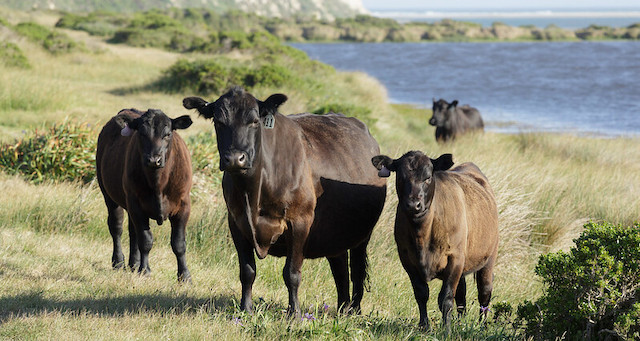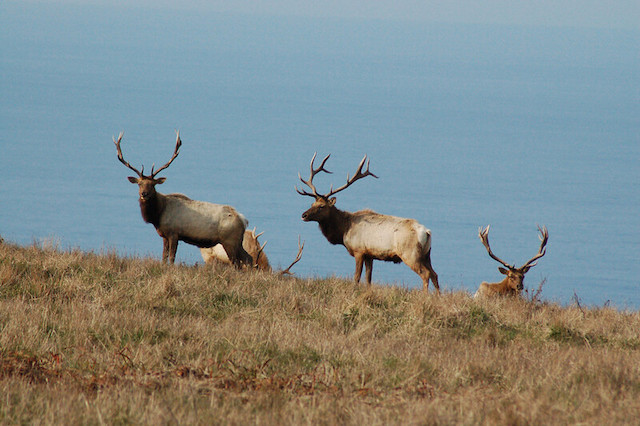Environmental groups are suing the National Park Service’s Point Reyes National Seashore to stop a plan to kill elk (which are native to California) in order to provide more grass for cattle (which are not). Point Reyes is one of the few units of the National Park System that allow cattle grazing, and the ranchers whose cattle use the area claim that the elk are in their way.
Cattle grazing in Point Reyes National Seashore pollute streams and spread disease to native elk. Photo by John Loo.
This is the same Point Reyes that shut down an oyster farm, fabricating claims that the “oyster feces” were “smother[ing] native species” of plants, which was never proven. The reality is that oyster farmers do their best to preserve water quality as oysters themselves are highly sensitive to pollution. Despite the exposure of these fraudulent claims, then-Secretary of the Interior Ken Salazar shut down the operation, saying that no commercial activities should be allowed in the parks.
So why are ranchers still allowed to graze cattle? Defenders say that allowing them to do so helps “preserve a way of life,” which could have been said for the oyster farm as well. But cattle ranching as a way of life continues on millions of acres of Forest Service and Bureau of Land Management lands that were not suited for oyster farming.
Point Reyes National Seashore was private land until it was purchased by the federal government in the 1970s. The existing oyster farmer was given a 40-year permit to continue growing oysters; existing cattle ranchers were given 20-year permits to graze their cattle. The Park Service refused to renew the oyster farming permit when it expired; the cattle permits have been renewed at least twice, and the Park Service says it has no intention of not renewing them the next time they expire.
According to a Park Service report, several creeks and watersheds in the national seashore have very high levels of coliform bacteria, a sign that the cattle are polluting the streams. The cattle also bring in noxious weeds and have been known to spread diseases to the elk.
Tule elk in Point Reyes National Seashore. Photo by kqudquest.
The subspecies of elk native to the seashore, known as Tule elk, had been heavily hunted by early settlers and was thought to have gone extinct by 1870. However, a single breeding pair was found in 1874 and from it the subspecies now has a population of more than 4,000. The Park Service’s plan for the seashore calls for limiting the number of elk to just 140 and culling any excess numbers beyond that. The Center for Biological Diversity, Western Watersheds Project, and other environmental groups are challenging this plan.
Having worked closely with environmentalists for nearly two decades, I’ve grown a bit skeptical about many of their claims, which are often exaggerated. But I’m also highly skeptical of a ranching industry that depends on federal lands for grazing cattle and other livestock. Most federal lands are so marginal that they contribute little to overall agricultural production but cost taxpayers an enormous amount.
One major issue is how much ranchers have to pay. At $1.35 per animal unit month (the amount of grazing a cow and calf would do in one month), grazing fees on national forest and BLM lands are far too low. Park Service fees are higher but still only about half what private landowners typically charge.
Point Reyes doesn’t need cattle grazing. Americans will survive without beef and dairy products grown on Point Reyes. The Park Service should not renew grazing leases when they expire and it certainly should not shoot elk just to allow a few more cattle to pollute the national seashore.










Compared to trees grass grows quickly. Why not commercially harvest the 40 million acres of lawn across the US.
Why ranchers aren’t taking care of there land…much like the Dust bowl 70 years ago, Farmers on the other hand learned the lesson of proper soil management.. ranchers never learned that lesson…
Ranchers are mobile people, so shtf they mosey on to greener pastures. 70 years of environmental laws have changed that.
Lot of western states get paid to landfill, they should separate and compost organic waste to rehabilitate damaged soils back into grazing productivity. Grazing animals like cows eat down to root. Wild grazers eat til the grass blades snap…
Ecologists and soil scientists are gonna have to get involved if ranchers wanna continue to carry on their lifestyle.
Deconstructing stupidity:
“Compared to trees grass grows quickly.”
Wow! You don’t say?
“Why not commercially harvest the 40 million acres of lawn across the US.”
Because that is a retarded idea.
“Why ranchers aren’t taking care of there land”
They are taking care of their land, and to claim they aren’t without any evidence further exposes your intellectual impotence. Also, it’s their not there.
“Farmers on the other hand learned the lesson of proper soil management.. ranchers never learned that lesson…”
Making shit up.
“Ranchers are mobile people, so shtf they mosey on to greener pastures.”
More retarded BS.
“Lot of western states get paid to landfill, they should separate and compost organic waste to rehabilitate damaged soils back into grazing productivity.”
Sure. Spread some more invasive species.
“Ecologists and soil scientists are gonna have to get involved if ranchers wanna continue to carry on their lifestyle.”
Nope.
Say hi to your mom for me.
Although grass is harvested at a younger age than trees, grass does not grow more quickly than trees. The annual average productivity of southern pine is about 10 tons/acre. The annual average productivity of switchgrass is 5-10 tons/acre.